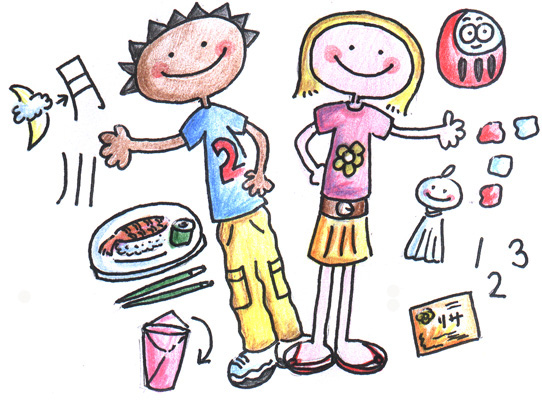Lesson 8
Lesson Plan Download pdf
Starter (15 minutes)
Refresh the verbs ‘tabemasu’ and ‘nomimasu’ by showing various pictures of food and drink (using the flashcards or the presentations) and have the children respond in whole sentences:
Take a bite of a banana (or similar) and using smiley, happy gestures say:
Repeat this sentence five times and have the children do the same.
Repeat with a different food. Ask, “What do you think I’m saying?” (Hold up the ‘thumbs up’ flashcard as a prompt).
Grammar note:
‘suki’ - to like
‘wa’ and ‘ga’ are particles in the sentence and have no real direct translation.
Demonstrate the following conversation with the Japanese teacher, or use the dialogue soundfiles:
Note: ‘hai - はい’ means ‘yes’.

Ask for a show of hands of all those children who also like bananas. Go round and ask the children the above question. Children then practise in pairs.
Take a bite of Marmite (or similar) and pull a disgusted face:
Watashi wa mamaito ga suki jya nai desu. 私はマーマイトが好きじゃないです。
What do you think this means? Discuss. (Use the ‘thumbs down’ flashcard as a prompt). Explain that ‘suki jya nai’ means ‘dislike’. ‘jya nai’ is a negative marker.
Repeat these structures – ‘watashi wa noun ga suki/ suki jya nai desu’ using various different fruits (use the food and drink presentation and flashcards to help):
Now try out a conversation, using the soundfiles to model good pronunciation:

| A: | melon wa suki desu ka. | Do you like melon? |
| メロンは好きですか。 | ||
| B: | iie, watashi wa melon ga suki jya nai desu. | No, I dislike melon. |
| いいえ、私はメロンが好きじゃないです。 | ||
Note: いいえ means ‘no’
Language awareness point:
Having established that melon, pineapple, orange and kiwi sound very similar
in both Japanese and English, have the children make an educated guess as
to what strawberry, apple and grapes may be. If following the above pattern,
they should be: sutoroberi, appuru, gurepusu (although are actually different
words altogether!)
However, you may find shops selling ‘appuru jusu’ etc - using the loan word for emphasis/ fashion.
Another Option!
Children could play the following game as a means of revision: Sit in a
circle and go around the class with each pupil repeating what food / drinks
other members of the class like and dislike. Once this has been completed
successfully, they then have to state a food they themselves like or dislike,
and so the game continues:
John wa ko>ra ga suki jya nai desu. Nicola wa banana ga suki desu. Watashi wa chizu ga suki desu…
ジョンはコーラが好きじゃないです。二コラはバナナが好きで す。私はチーズが好きです。
John doesn’t like cola. Nicola likes bananas. I like cheese… Who can remember the most?
Alternatively, children could fill in worksheet A, which accompanies this lesson. Each pupil asks their classmates in Japanese whether they like or dislike a certain TV star, sports player, food, pop star, colour etc and the children have to record their answer with either a cross (batsu) or circle (maru). In Japan, if children give the correct answer, the teacher will mark it with a circle rather than a tick.
